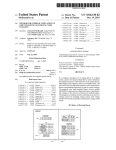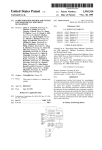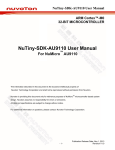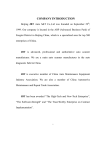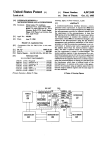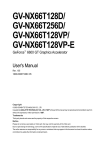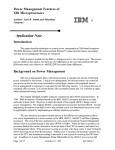Download Method for identifying and correcting errors in a central processing unit
Transcript
US006202174B1 (12) United States Patent (10) Patent N0.: (45) Date of Patent: Lee et al. (54) METHOD FOR IDENTIFYING AND Allen, J .R., & Yau, S.S., “Real—time fault detection for small computers”; May/1972; pp. 119—127.* “PoWerPC 602 Aims for Comsumer Products”, Linley (76) Inventors: Sherman Lee, 28531 Cedarbluff Dr., Rancho Palos Verdes, CA (US) 90274; David G. Kyle, 3107 Barton Point Cir., Austin, TX (US) 78733 Notice: GWennap, Microprocessor Report, Feb. 16, 1995, pp. 16—18. “Intel’s P6 Uses Decoupled Superscalar Design”, Linley GWennap, Microprocessor Report, Feb. 16, 1995, pp. 9—15. “New Algorithm Improves Branch Prediction”, Linley GWennap, Microprocessor Report, Mar. 27, 1995, pp. Subject to any disclaimer, the term of this patent is extended or adjusted under 35 17—21. U.S.C. 154(b) by 0 days. (List continued on next page.) Primary Examiner—Dieu-Minh T. Le (21) Appl. No.: 08/710,336 (22) Filed: Sep. 16, 1996 (74) Attorney, Agent, or Firm—Skjerven, Morill, MacPherson, Franklin & Friel LLP; Omkar K. Suryadevara (57) (51) Int. Cl.7 .................................................... .. G06F 11/00 (52) US. Cl. ............................ .. 714/38; 714/47; 714/704; ABSTRACT Acentral processing unit (CPU) repeatedly interrupts execu tion of softWare to save the CPU state, i.e. contents of various storage elements internal to the CPU, until an error occurs during the execution. On occurrence of the error, the CPU once again saves state and only then passes control to a handler in the softWare for handling the error. The state 710/266 (58) Mar. 13, 2001 OTHER PUBLICATIONS CORRECTING ERRORS IN A CENTRAL PROCESSING UNIT (*) US 6,202,174 B1 Field of Search ....................... .. 395/183.14, 183.13, saving steps can be implemented in a computer process by 395/183.15, 184.01, 185.01, 704, 708, 733, 734, 739; 364/267, 267.91, 737; 714/38, use of a timer interrupt or by use of system management, or ICE breakpoint instructions that are included in the X86 instruction set. Errors can be debugged off-line in a devel opment system, for example, by use of an in-circuit emulator 37, 39, 47, 48 (56) References Cited to load the saved CPU states sequentially into the develop ment system, thereby to recreate the error condition. Errors can also be debugged proactively, even before the error occurs, by use of a number of knoWn-to-be-erroneous U.S. PATENT DOCUMENTS 3,905,023 * 9/1975 Perpiglia ....................... .. 395/18204 4,410,938 * 10/1983 Higashiyama . 395/184.01 4,412,285 * 10/1983 Neches et al. . 4,792,955 12/1988 Johnson et al. .. 395/200.82 ....... .. 371/68 4,819,234 * 4,982,402 * 4/1989 1/1991 395/183.14 .. 395/182.13 5,119,377 * 6/1992 Cobb et al. 5,125,087 6/1992 * Huber ....... .. Beaven et al. . Randell 5,214,652 * 5/1993 Sutton 5,437,039 5,533,192 * 7/1995 7/1996 ...... instructions and corresponding ?x instructions. For proac tive debugging, the CPU compares instructions to be executed With each of the knoWn-to-be-erroneous instructions, and on ?nding a match, injects the correspond ing ?x instructions into the to-be-executed instructions. .. 395/183.14 . . . . . . .. Therefore, known errors eg the PENTIUM arithmetic bug are avoided, e. g. by replacing one arithmetic instruction With 395/568 395/18208 another arithmetic instruction. Moreover, if an error has not Yuen ........ .. 395/725 Hawley et al. ............... .. 395/183.04 yet been debugged, a temporary ?x instruction can be used to gracefully terminate an application. FOREIGN PATENT DOCUMENTS 442277A2 * of 1991 11 Claims, 5 Drawing Sheets (EP) . (2:0 Low APPumwN RUN APPUCATlEIN \ ERROR’ TERMWAIE APPUEAT‘ON / g. 4 j at; / oPmnucsvsrm 11 1 a CPU sure SAVER \ l1 / / / US 6,202,174 B1 Page 2 OTHER PUBLICATIONS Pietrek, Matt, “Postrnortern Debugging”, Dr. Dobb’s Journal “The Dr. Watson Diagnostic Tool”, Technical Articles: Win on CD—ROM, Sep. 1992, pp. 1—12. “Nx686 Goes Toe—to—Toe With Pentiurn Pro”, Linley doWs: Development Environrnent—Microsoft Development Library, pp. 1—7, May 1994. “An Annotated Dr. Watson Log File”, KBzWindows SDK KBase—Microsoft Development Library, PSS ID No.: Q81142, Jun. 1995, pp. 1—4. “WW0440: The DrWatson and MSD Diagnostics”, KBzWindows 3.x KBase—Microsoft Development Library, PSS ID No.: Q75020, Jul. 1995, pp. 1—7. Wolfe, Alexander, “Intel equips its P6 With test and debug features”, Electronic Engineering Times Oct. 16, 1995 n870 p1(2), Cornputer Select, Dec. 1995, pp. 1—3. Graharn, AndreW J ., “Pro?ting frorn standards”, Electronic Engineering Times Oct. 23, 1995 n871 p24(2), Cornputer GWennap, Microprocessor Report, Oct. 23, 1995, pp. 6—10. “Hal Reveals Multichip SPARC Processor”, Linley GWen nap, Microprocessor Report, Mar. 6, 1995, pp. 6—11. “Cornputer OrganiZation and Design”, John L. Hennessy, etc., Morgan Kaufrnann Publishers, Chapter 7, pp. 502—504. “Intel Equips Its P6 With Test and Debug Features”, Alex ander Wolfe, Electronic Engineering Times, Oct. 16, 1995, pp. 1, 106. “P6 Stirs Up SoftWare Issues”, Alexander Wolfe, Electronic Engineering Times, Oct. 30, 1995, p.22. “Intel’s Potent P6 Prerniers”, Alexander Wolfe, Electronic Select, Dec. 1995, pp. 1—3. Daniel, Wayne, “Test bus takes a ride on popular PCI”, Engineering Times, Oct. 30, 1995, pp. 1, 22, 24. PentiurnTM Processor User’s Manual, vol. 1, Chapter 3, Intel, Electronic Engineering Times Oct. 16, 1995 n870 p55(1), Cornputer Select, Dec. 1995, pp. 1—3. The Complete X86, John Wharton, vol. II, Chapter 20, 1994, 1993, pp. 3—1 to 3—25. Hlavaty, Joseph, “Exception Handlers and WindoWs Appli pp. 639—679. cations”, Dr. Dobb’s Journal on CD—ROM, Sep. 1994, pp. 1—15. * cited by exarniner U.S. Patent Mar. 13, 2001 220 \ START US 6,202,174 B1 Sheet 4 0f 5 START LOAD APPLICATION RUN APPLICATION WAIT FOR STATE SAVING EVENT ERROR TERMINATE READ AND COMPARE KNOWN-TO-BE ERRONEOUS INSTRUCTIONS \ 215 APPLICATION L__ INJECT FIX INSTRUCTION IF NECESSARY OPERATING SYSTEM ENTER CRITICAL SECTION SAVE CPU STATE APPLICATION 1 \ 218 1i EXIT CRITICAL SECTION ~\ 219 __I CPU STATE SAVER I 13I0A-130N / 129A-120M // FIG. 2 CPU STATES APPLICATIONS HARD DISK DATA US 6,202,174 B1 1 2 METHOD FOR IDENTIFYING AND CORRECTING ERRORS IN A CENTRAL PROCESSING UNIT MICROSOFT Corporation further recommends that after a CROSS-REFERENCE TO RELATED APPLICATIONS manufacturer, installed processor(s), I/O port status, operat ing system version, environment settings, hardWare devices attached, and additional softWare running concurrently With UAE occurs, the user should run MICROSOFT DIAGNOS TICS (MSD) that identi?es system con?guration information, such as the BIOS, video card type, This application is related to and incorporates by refer ence herein in their entirety the following commonly oWned, concurrently ?led, copending US. Patent Applications: MSD. Id. All of these actions can result in loss of valuable data, as Well as valuable time before a user can continue 10 1. “A Port For Fine Tuning A Central Processing Unit” by MICROSOFT Corporation also recommends that after logging several UAEs, the user should send the log to Sherman Lee and David G. Kyle, Ser. No. 08/710,337, now US. Pat. No. 5,937,203, issued on Aug. 10, 1999. 2. “A Method For Fine Tuning Operation of Circuitry In A Central Processing Unit” by Sherman Lee and David G. MICROSOFT Corporation, although MICROSOFT Corpo ration cannot respond to log contributors. Id. Therefore, the 15 Kyle, Ser. No. 08/710,294, now US. Pat. No. 5,812,425, issued on Sep. 22, 1998. for debugging other errors, such as errors in the operating 20 a programmed digital computer and for correcting the iden “debug” port of the type present in INTEL’s P6 (also called “Pentium Pro”) microprocessor. INTEL recommends the lyZing the monitored instructions and data to predict errors P6’s debug port as an aid for designing a system board on 25 by inserting corrective softWare. BACKGROUND OF THE INVENTION MICROSOFT Corporation’s Dr. Watson is a debugging 30 tool that logs information regarding internal operations of the operating system “WINDOWS” into a failure report. Dr. Watson logs the information after any application softWare (typically called just “application”) encounters an error, that MICROSOFT calls “unrecoverable application error (UAE).” See, for example, “An Annotated Dr. Watson Log File,” KBzWindows SDK KBase, Microsoft Development Library, MICROSOFT Corporation, One Microsoft Way, Redmond, Wash.; “Postmortem Debugging,” Matt Pietrek, Dr. Dobb’s Journal, September 1992; and “Exception Han dlers and WindoWs Applications,” Joseph Hlavaty, Dr. Dobbs Journal, September 1994; all of Which are incorpo rated by reference herein in their entirety. Brie?y, a Dr. Watson failure report contains information on (1) the name of an application that failed, (2) the error system or errors in hardWare. Errors in hardWare can be debugged using a built-in ti?ed errors. In particular, this invention relates to a method for monitoring instructions and data that cause errors, ana and for preventing future errors from occurring, for example user receives no assistance in identifying the problem that caused the UAE and in ?xing the application to avoid that particular UAE in future. Moreover, Dr. Watson appears to log only an application’s UAEs failures, and cannot be used FIELD OF THE INVENTION This invention relates to a method for identifying errors in using the application. Which the CPU is mounted. See, for example, “Intel equips its P6 With test and debug features,” Electronic Engineering Times, Oct. 16, 1995, n870, pages 1-2, that is incorporated by reference herein in its entirety. Brie?y, the P6 debug port is typically connected to an “in-target probe” (ITP) via a 30-pin connector, and alloWs access to boundary-scan (JTAG) and built-in-self-test (BIST) structures on the P6 microprocessor. Through an ITP such as ICE-16 available from, for example, American 35 Arium, Tustin, Calif., board designers can control program execution, set break points, monitor the P6’s access of registers, memory and input-output devices. HoWever, a typical user neither has access to an ITP nor 40 the expertise needed to use the ITP. Therefore, the user is still unable to identify the problem that causes a UAE and unable to ?x the application to avoid knoWn UAEs in future. SUMMARY 45 In accordance With the invention, a central processing unit (CPU) repeatedly interrupts execution of softWare to save encountered, such as “Exceed Segment Bounds (Read),” (3) the CPU state, ie contents of various storage elements the instruction’s address at Which the failure occurred, (4) the instruction that caused the failure, (5) the contents in various registers, such as CPU registers, instruction pointer internal to the CPU, until an error occurs during the execu tion. On occurrence of the error, the CPU once again saves state and only then passes control to a handler in the softWare for handling the error. Each time the CPU state is saved at locations in memory different from the previous (also called “program counter”), stack pointer, base pointer, code segment selector, stack segment selector, data segment selector, extra segment selector, 32-bit registers and ?ag bits (e. g. Over?ow bit, Direction bit, Sign bit, Zero bit, Carry bit, time so that a sequence of CPU states is saved When control passes to the handler. The storage elements Whose contents Interrupt bit, Auxcarry bit and Parity bit), (6) WINDOWS installation and environment information, (7) stack frame 55 information such as disassembled instructions surrounding the failed instruction, and several levels of nested function calls leading to the failed instruction, (8) names of all tasks When the failure occurred and (9) user response typed into a “Dr. Watson’s Clues” dialog box. 60 MICROSOFT Corporation recommends that a user exit WINDOWS after a UAE occurs, and if exiting is not possible, to restart the personal computer. See “The DrWat son and MSD Diagnostics,” KBzWindows 3.x KBase, Microsoft Development Library, MICROSOFT Corporation, One Microsoft Way, Redmond, Wash., also incorporated by reference herein in its entirety. are saved can be of tWo types: (1) accessible, and (2) inaccessible to the executing softWare, such as an operating system or an application. Moreover, the above-described state saving steps can be implemented, in different embodi ments of the invention, in hardWare (eg as a state machine) or in softWare (eg in basic-input-output-system (BIOS), in an operating system, as a device driver, or as a utility). In one speci?c embodiment, the state saving steps are implemented in a computer process by use of x86 instructions.1 1 The x86 instruction are instructions executable by microprocessors com patible With microprocessors in the 8086, 80286, 80386, 80486, Pentium and Pentium Pro (P6) families of microprocessors available from Intel Corpora 65 tion, Santa Clara, Calif. In one embodiment, errors are debugged off-line in a development system, for example, by use of an in-circuit US 6,202,174 B1 3 4 emulator to load the saved CPU states sequentially into the development system, thereby to recreate the error condition. If the frequency of the saved CPU states is too coarse to ?nd softWare for handling the error. The storage elements Whose contents are saved can be of tWo types: (1) accessible, and (2) inaccessible to the executing softWare, such as an oper ating system or an application. The state saving steps can be implemented in a computer process by use of system man agement instructions that are included in the x86 instruction set. Errors can be debugged off-line in a development system, for example, by use of an in-circuit emulator to load the saved CPU states sequentially into the development the source of the error, the CPU states can be saved more frequently, eg after shorter time periods, on every jump instruction, on every input-output instruction, on every function-call instruction, or on some combination these events, depending on one or more ?ags. The ?ags can be set, for example, in a con?guration ?le that is checked at the startup of the computer process. The sequence of saved CPU 10 states alloWs recreation of error conditions otherWise not possible in the prior art. Moreover, the CPU states are saved transparent to the softWare, thereby alloWing recreation of errors in an operating system as Well as errors from inter action betWeen the operating system and an application, 15 both of Which Were not possible in the prior art. system, thereby to recreate the error condition. Errors can also be debugged proactively, even before the error occurs, by use of a number of knoWn-to-be-erroneous instructions and ?x instructions corresponding to the knoWn-to-be erroneous instructions. Speci?cally, the CPU compares instructions to be executed With each of the knoWn-to-be erroneous instructions, and on ?nding a match, injects the corresponding ?x instructions into the to-be-executed In accordance With the invention, an error can also be instructions. Therefore, knoWn errors eg the PENTIUM debugged proactively by a computer process, even before arithmetic bug are avoided, eg by replacing one arithmetic instruction With another arithmetic instruction. Moreover, if the error occurs, by use of a number of knoWn-to-be erroneous instructions and ?x instructions corresponding to the knoWn-to-be-erroneous instructions. In one embodi ment, the CPU compares instructions to be executed With each of the knoWn-to-be-erroneous instructions, and on 20 ?nding a match, injects the corresponding ?x instructions an error has not yet been debugged, a temporary ?x instruc tion can be used to gracefully terminate an application that Would otherWise “freeze” the CPU. In one embodiment, the above-described CPU is a “tun able CPU” having a number of tunable units, With each into the to-be-executed instructions. In this embodiment, these proactive error debugging steps are executed by the state saving process optionally depending on a ?ag that is set or cleared, for example, in a con?guration ?le. In another embodiment, the proactive error debugging steps are imple 25 tunable unit having one or more parameters that can be mented in a different process that executes independent of the state saving process, i.e. does not save CPU states. 30 changed, to thereby change circuitry in the CPU. Examples steps are implemented in a computer process that ?ne tunes the tunable CPU. The computer process Waits for a trigger Therefore, Well knoWn errors eg the 80286 jump bug or the PENTIUM arithmetic bug are easily avoided, eg by inserting a no-op instruction before a jump instruction or by replacing one arithmetic instruction With another arithmetic instruction. Such proactive debugging alloWs a user to continue to use, for example, a defective PENTIUM or defective softWare and not have any knoWn errors. More over, if an error has not yet been debugged, the handler can add an erroneous instruction to the knoWn-to-be-erroneous ing event indicating the need for ?ne tuning of the tunable 35 CPU, reads one or more statistics on performance of the tunable CPU, compares the read statistics With predeter mined statistics patterns to determine one or more parameter signals, and drives the parameter signals to one or more tunable units, thereby to change the circuitry in the tunable 40 instructions With a corresponding temporary-?x instruction to gracefully terminate the application, eg if the erroneous instruction is knoWn to crash (e.g. “freeZe”) the CPU. Such graceful termination of the application alloWs the CPU to continue execution of other softWare that may be of value to a user, eg to eliminate the need to reboot the operating 45 ments Will be obvious to a person skilled in the art of the disclosure. Accordingly, the embodiments described herein are merely illustrative and not limiting. In one embodiment, a computer system 100A includes a CPU 110A having a built-in CPU state saver 110S. CPU state saver 110S repeatedly saves the state of CPU 110A, such as contents of storage elements 110D—110N as FIGS. 1A—1C each illustrate a central processing unit (CPU) circuitry tuner in three different embodiments of a computer system. FIG. 2 illustrates, in a high level ?oWcharts and block DETAILED DESCRIPTION In accordance With the invention, a central processing unit (hereinafter “CPU”) repeatedly interrupts execution of soft Although speci?c circuitry is described herein for a particular embodiment of the invention, other such embodi designing debugging systems for microprocessors in vieW of BRIEF DESCRIPTION OF THE DRAWINGS tuner of FIGS. 1A—1C. FIG. 3 illustrates addresses and contents of main memory 120 and system management memory 130 in one embodi ment of the invention. CPU. Examples of steps for ?ne tuning the tunable CPU are described in the above-incorporated application, Ser. No. 08/710,294 now US. Pat. No. 5,812,425, issued on Sep. 22, 1998. system otherWise required in the prior art. diagrams, various steps performed by the CPU-circuitry of circuitry in a tunable unit and a device (called “?ne tuning port”) for changing circuitry in the CPU are described in the above-incorporated application, Ser. No. 08/710,337 now US. Pat. No. 5,937,203, issued on Aug. 10, 1999. In this embodiment, the above-described state saving 55 60 described more completely beloW. In addition to CPU 110A, computer system 100A includes a read only memory 111 that is encoded With basic input output system instructions for CPU 110A. Read only memory 111 and CPU 110A are coupled to each other by a CPU bus 112 that is also coupled via a system bridge (not labelled) to a system bus 113. System bus 113 in turn is coupled to a ?oppy drive 114, a hard disk 115, a monitor 116, a keyboard 117 and a mouse 118. CPU bus 112 is also coupled to a main memory 120 that is encoded With a number of applications, eg application 120A . . . 120I . . . 120M, Where M is the number of Ware to save the CPU state, i.e. contents of various storage elements internal to the CPU, until an error occurs during the 65 applications. execution. On occurrence of the error, the CPU once again In addition to the above-described parts, computer system saves state and only then passes control to a handler in the 100A also includes a system management memory 130 that US 6,202,174 B1 5 6 is coupled via CPU bus 112 to CPU 110A, and that is step 216 and injects one or more ?x instructions as neces accessible to CPU state saver 110S. System management sary. For example, a “no-op” instruction can be inserted before a jump instruction for the A0286 microprocessor. As memory 130 is typically “hidden” from i.e. made inacces sible from applications 120A—120M in the manner described in, for example, “The CPU and Undocumented Instructions,” Chapter 3 of the book “The Undocumented another example, an arithmetic instruction to the PENTIUM can be replaced by a series of arithmetic instructions that Work around the error. PC” by Frank van GilluWe, Addison-Wesley Publishing Next, CPU state saver 210 enters a critical section in step Company, Reading, Mass.; this book is incorporated by 217, for example by disabling interrupts and serialiZing (e.g. reference herein in its entirety. In this embodiment, system management memory 130 holds a number of CPU states e.g. making sequential) the execution of instructions in CPU 10 CPU state 130A, . . . 130I, . . . 130N, Where N is the number of CPU states. CPU states for one embodiment are described beloW in reference to FIG. 3. In this embodiment, CPU state saver 110S in CPU 110A is implemented in hardWare as circuitry that performs a 15 number of steps illustrated in FIG. 2 (described beloW). In an alternative embodiment, CPU state saver 110S is encoded as microcode resident in storage elements (not shoWn) in CPU 110A that also performs the steps of FIG. 2. In another embodiment, a CPU 110B (FIG. 1B) does not have the 110A. During this step, if necessary, CPU state saver 210 also sWitches from main memory 120 to system manage ment memory 130 that is inaccessible to applications 120A—120M. After entering the critical section, CPU state saver 210 goes to step 218 and stores the CPU state in memory, such as system management memory 130 or main memory 120. Depending on the identity of CPU 110A, one of the save state instructions in Table 1 is used to save the CPU state. TABLE 1 above-described CPU state saver 110S, but rather has a softWare version, CPU state saver 1115 that is encoded in read only memory 111 in addition to the Basic Input Output System (BIOS) instructions. CPU state saver 111T also performs the steps described beloW in reference to FIG. 2. CPU Iden25 tity Note that the same reference numerals are used for various parts in FIGS. 1B and 1C that are similar or identical to the AMD corresponding parts in FIG. 1A. In yet another embodiment of the invention, both CPU 110C (FIG. 1C) and read only memory 111C do not have a AMD CPU state saver 110S or 111s. Instead, a softWare version, CPU state saver 120S is encoded in main memory 120C. In IBM 386SLC addition, computer system 100C does not have system 486SLC management memory 130, and rather CPU states Intel 386SL Save State Instruc- Number of Bytes Address for Storing Current Address for Save State Saved CPU State Software tion OpCode SMI F1h 228 6000:0h FFFFFFFOh SMI F1h 228 6000:0h FFFFFFFOh SMI F1h 364 6000:0h FFFFFFFOh ICEBP F1h 284 6000:0h FFFFFFFOh ICEBP F1h 284 6000:0h FFFFFFFOh Timer Interrupt OFh, 30h; note: 512 3000:FEOOh 3000:8000h from 8236OSL enable bit 5 in model 512 3000:FEOOh 3000:8000h 386SXLC (reset) 386DXLC AMD (reset) 486DXLC IBM 130A—130N are saved in main memory 120C. In this embodiment as Well, CPU state saver 120T performs the steps described beloW in reference to FIG. 2. A CPU state saver 210 in one embodiment of the inven tion initialiZes variables on start up in a step 211 and thereafter checks in step 212 Whether the state of CPU 110A (reset) (reset) (reset) speci?c register lOOOh Intel 486SL (FIG. 1A) can be saved, and if not stops in step 213. Step 212 can be implemented, for example, by determining the identity of CPU 110A and jumping to instructions speci?c to the determined identity for the folloWing steps. The identity Timer Interrupt OFh, 30h; note: from 8236OSL enable bit 5 in model speci?c register 1000b of CPU 110A can be determined, for example, as described in “System Equipment and Detection,” Chapter 4 of the book “The Undocumented PC” incorporated by reference Similarly, a store instruction can also be used to store CPU state in memory. The data saved in a CPU state 130A is above. illustrated in Table 2 for an INTEL microprocessor (see pages 88—90 of the above-referenced book by Frank van GilluWe for more details). If the CPU state is savable, CPU state saver 210 stores one of the CPU state 130A—130N into memory. Then CPU state saver 210 goes from step 212 to step 213 and Waits for an event indicating the need for saving CPU state. The state TABLE 2 saving event can be, for example, the loading and running of an application program by the operating system or a system interrupt that occurs periodically, e.g. every ?ve second or System Management Total Word 10 seconds during the running of an application. The CPU Memory Offset Stored state can be saved more frequently, eg by having CPU state on every jump instruction, on every input-output instruction FEOO 124 FEF8 2 55 Unknown State Dump Base-This holds the internal register value of the segment for the or on every functionicall instruction, or some combination depending on ?ags in eg storage element 110D. Suspend code and storage of On occurrence of such an event, CPU state saver 210 goes to step 215 and analyZes (as described more completely beloW) the to-be-performed instructions. The CPU state is Data Stored in CPU State this table. It defaults to 3000b. FEFC 1 System Management Mode Bits bit 0 = 1 CPU supports also saved on occurrence of an error-in Which case CPU 65 I/O Trap restart state saver 210 skips steps 215—215 (described beloW) and bit 1 = 1 CPU supports goes directly to step 217. Then, CPU state saver 210 goes to US 6,202,174 B1 8 7 necessary. CPU state saver 210 does not ?ush a cache memory (not shown) in any of the above-described steps. TABLE 2-continued System Management Total Word Memory Offset Stored Thereafter, CPU state saver 210 returns to step 214 and awaits another state saving event. Although certain speci?c embodiments have been Data Stored in CPU State FFFE 1 state dump base changes System Management Mode FFOO 1 I/O Trap restart-Always set FFO2 1 described herein, numerous modi?cations and adaptations of the described embodiments will be obvious in view of the disclosure. Revision Number to Zero when saved. For example, instead of proactive debugging of error by 10 Halt auto restart-This value is set to 1 if SMI occurred instruction. Otherwise it system. Such sequential loading of CPU states can recreate is set to O. 51 1 1 1 1 1 1 1 1 1 1 1 1 Unknown ES Unknown CS Unknown SS Unknown DS Unknown FS Unknown GS Unknown FFCO 1 FFC2 1 Unknown FFC4 1 TR-Task Register FFC6 FFC8 FFCC FFDO FFD4 FFD8 1 2 2 2 2 2 Unknown DR7 DR6 EAX ECX EDX FFDC 2 EBX FFEO FFB4 FFE8 FFEC FFFO FFF4 FFF8 FFFC 2 2 2 2 2 2 2 2 ESP EBP ESI EDI EIP EFLAGS CR0 CR1 LDTR-Local Descriptor Table 15 states 130A—130N, or can be recreated by a person skilled sors. 20 25 30 35 (Table 1), various CPU registers such as registers CR1, CR2, CR3 and CR4, DRO—DR7 and ?oating point registers STn, FCS, FSW, FIP, tag word and ?oating point op code can also be saved as part of the CPU state. The amount of data to be 40 saved in a CPU state is limited only by the size of the system management memory, and the number of saved CPU states required for debugging. If the number of bytes being saved is small, e. g. 228 bytes, several thousand states can be saved in, for example, one MB of system management memory. Alternatively, if several thousands of bytes are saved in a 45 saver 2 can also save the contents of a data cache as part of the CPU state. Alternatively, CPU saver 210 can save state on every input-output instruction, thereby to record data operands from as the operands and to CPU 110A. Therefore, single CPU state (eg if data cache is also saved), only a handful of CPU states may be saved in, for example, 32 MB of system management memory. Numerous such modi?cations and adaptations of the above described embodiments are encompassed by the attached claims. We claim: 1. Acomputer process for identifying an error in a central processing unit (CPU), the computer process comprising: the storage elements whose contents are saved are of two types: (1) accessible and (2) inaccessible to the executing 55 executing software in said CPU, wherein the software comprises a plurality of instructions; repeatedly interrupting said executing by said CPU, and saving contents of storage elements in said CPU until an error occurs during said executing, said contents saved at each interruption forming one state in a The current CPU state 130C saved at the address 3000: FE00h is then copied by CPU state saver 210 as shown by 60 If CPU State Saver 210 executes step 218 due to an error, CPU state saver 210 copies all of CPU states 130A—130N to sequence of states of said CPU maintained by said repeatedly saving; comparing an instruction in said plurality of instructions with a known-to-be-erroneous instruction prior to hard disk 115. Thereafter, CPU state saver 210 goes to step 219 and exits In the step 219, CPU state saver 210 also switches from system management memory 130 to main memory 120 as reboot the operating system that would otherwise have been required in the prior art. Moreover, any information related to the central process ing unit can be saved as a part of the CPU state. For example, if not saved by the above-described save state instruction tem speci?c information, such as the names of all tasks from the critical section, for example by enabling interrupts. application, eg if the erroneous instruction is known to crash (e.g. “freeZe”) the CPU. Such graceful termination of an application allows the CPU to continue the execution of other software. Such execution of other software may be valuable to a user, for example by eliminating the need to running when the failure occurred and other information of the type saved by Dr. Watson as described above. CPU state arrows 301A—301N to one of CPU states 130A—130N. In another variation of one embodiment, when an error has not yet been debugged, an error handler in the software being executed adds an erroneous instruction to the known to-be-erroneous instructions, with the corresponding temporary-?x instruction to gracefully terminate the In addition to the above-described contents of storage elements, in this embodiment, CPU state saver 210 also saves application-speci?c information, such as the name of software. In this particular embodiment, the CPU state is automatically stored at the memory location 3000: FE00h (FIG. 3) on execution of a save state instruction (Table 1). the error condition by executing the error-causing software, if all of the necessary data is available, for example in CPU in the art of designing debugging systems for microproces Register an application, stack frame information, and operating sys a development system, for example by use of an inserted emulator (not shown) to load the saved CPU states 130A—130N (FIG. 2) sequentially into the development while the CPU was in a HALT FFD4 FFA8 FFAA FFAC FFAE FFBO FFB2 FFB4 FFB6 FFB8 FFBA FFBC FFBE CPU state saver 210, errors can also be debugged off-line in execution of said instruction in said plurality of instruc 65 tions; and injecting a ?x instruction into the plurality of instructions on ?nding a match during said comparing, said ?x US 6,202,174 B1 10 instruction corresponding to the knoWn-to-be 8. The computer process of claim 6 Wherein: erroneous instruction. said ?rst instruction causes an error on execution by said 2. The computer process of claim 1 Wherein the knoWn to-be-erroneous instruction is a jump instruction and the ?x CPU; and said second instruction is one of a group of instructions instruction is a no-op instruction. that When executed by said CPU avoid said error. 9. A computer process for identifying and correcting an error, the computer process comprising: 3. The computer process of claim 1 Wherein the knoWn to-be-erroneous instruction is a ?rst arithmetic instruction and the ?x instruction is a second arithmetic instruction. 4. A computer process for identifying and correcting an error in a central processing unit (CPU), the computer executing softWare, the softWare comprising an operating process comprising: repeatedly interrupting said executing and comparing a system and at least one application; executing softWare; to-be-executed instruction in the softWare With a knoWn-to-be-erroneous instruction thereby to detect an repeatedly interrupting said executing and comparing a to-be-executed instruction in the softWare With a ?rst predetermined instruction; and 15 injecting a second predetermined instruction correspond ing to the ?rst predetermined instruction into a plurality of to-be-executed instructions on ?nding a match dur ing said repeatedly interrupting. 5. The computer process of claim 4 Wherein said ?rst instruction is a ?rst arithmetic instruction and said second the knoWn-to-be-erroneous instruction is one of a sequence of knoWn-to-be-erroneous instructions; and instruction is a second arithmetic instruction. 6. The computer process of claim 4 Wherein: said ?rst predetermined instruction is knoWn to be erro neous; and upcoming error; and injecting into a plurality of to-be-executed instructions a ?x instruction corresponding to the knoWn-to-be erroneous instruction on ?nding a match during said comparing, thereby avoiding occurrence of said error. 10. The computer process of claim 9 Wherein: the ?x instruction is one of a sequence of ?x instructions 25 corresponding to the sequence of knoWn-to-be erroneous instructions. said second predetermined instruction implements a ?x for said ?rst predetermined instruction. 7. The computer process of claim 6 Wherein: 11. The computer process of claim 10 further comprising: adding to the sequence of knoWn-to-be-erroneous instruc said ?rst instruction causes a crash on execution by said adding to the sequence of ?x instructions an instruction CPU; and said second instruction terminates said executing thereby to avoid said crash. tions an erroneous instruction; and that terminates said executing.












